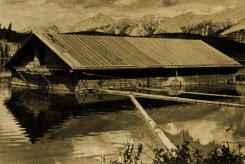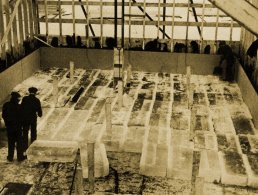Habbakuk
- "Floating seadrome made of ice" - World War II Code-name for this secret project
- Biblical prophet who said "Cast your eyes over the nations and be amazed, astounded. For I am doing something in your own days that you would not believe if you were told it" - Hab 1:5
- Note: alternative spellings, Habbakkuk, Habakkuk, Habakuk, etc.
Sir Winston Churchill, on board the Queen Mary in August of 1943, was on his way to the Quebec Conference, which would pave the way to the Normandy landings (operation Overlord) in 1944. He wrote "If we could create a floating airfield we could refuel our fighter aircraft within striking distance of the landing points, and thus multiply our air-power on the spot at the decisive moment. Among the numerous devices discussed during this busy voyage was one called 'Habakkuk' [1]"

Habbakuk
WWII project to fool the Germans with an overgrown aircraft carrier. "This project was conceived by a Mr. Pyke on Mountbatten's staff. His idea was to form a structure of ice, large enough to serve as a runway for aircraft. It would be of ship-like construction, displacing a million tons, self propelled at slow speed ... and with a surprisingly small refrigerating plant for preserving its own existence [2]".
Englishman, Geoffrey Nathaniel Pyke, invented "Pykrete" (Pyke / concrete) a mixture of ice and sawdust that was extremely strong and very slow to melt. Rumour has it that Winston Churchill was very impressed with a chunk of it that he experimentally took into his bath tub with him - but whatever the rumour, the Quebec Conference experienced a remarkable demonstration by the Chief of Combined Operations, Vice Admiral Lord Mountbatten. He first presented two blocks of ice about three feet tall, one of normal ice, the other of Pykrete. General Arnold, designated "strong man", cut the first in half with a large chopper, but hurt his elbows when he trid to swing at the Pykrete. Mountbatten administered the coup de grâce, shattering the real ice with his pistol, but the bullet shot at the Pykrete "ricochetted and narrowly missed [Marshal of the RAF] Portal [3]".
The original plan was for one (at least) "aircraft carrier" 3000 feet long, weighing in at 1.8 million tons. Walls 50 feet thick would house generators and refrigeration equipment to keep the thing from self-destructing. Then living quarters and even hangars would be added.

Habakkuk
The inevitable happened - costs got out of control. It was estimated it needed 8,000 men for 8 months and $70 million to build. Finally the British Combined Ops HQ put it quietly to rest, but not before a 60 foot by 30 foot "model" was built here in Canada (on Lake Patricia - or Patricia Lake - in the Jasper National Park, Alberta). This 1:50 scale model was built by just a handful of workers in two months, disguised to look like a boat house (to hide it from "enemy reconnaissance") weighed over a thousand tons and was completed in March 1943. They managed to keep it frozen during the summer of 1943 - and the remnants are still visible to divers.
- [ Back ] Footnote 1: W.S. Churchill "The Second World War", Volume V, Cassell, 1952, p69
- [ Back ] Footnote 2: ibid
- [ Back ] Footnote 3: ibid, page 81
- Shaun Ivory, "The ship that never was"
- L.W. Gold "The Habbakuk Project - Building Ships from Ice", Proceedings, International Symposium of Ice", POAC, Lulea, Sweden 1989, pp 1211-1228
- David Lampe "Pyke, the unknown Genius", Evans Brothers, London, 1959
- F.J. McEvoy "Professor Pyke's Secret Weapon", The Beaver, April/May 1994 p.32-39
- William J. Wallace "Habbakuk", Warship, volume V, number 18 1981 p.80-85
- G. Lindsey (ed.) "No Day Long Enough: Canadian Science in WWII", Canadian Institute of Strategic Studies, Toronto (1997), ISBN: 0-919769-65-9
- Delgado James P. (ed.) "Encyclopedia of Underwater and Maritime Archaeology", British Museum Press, 1997 or Yale University Press, 1998, p.186
